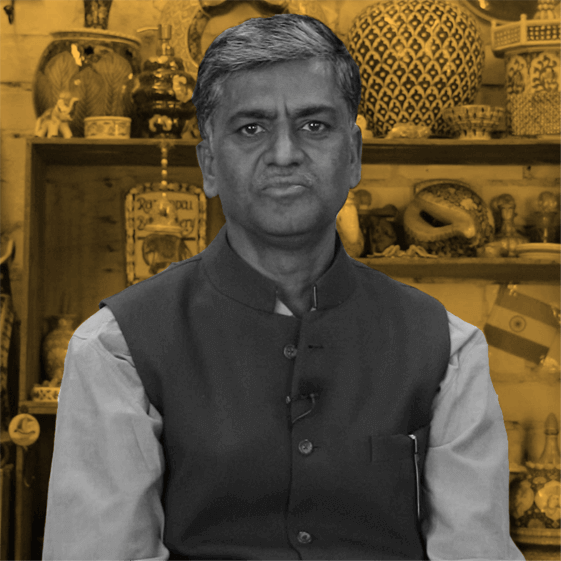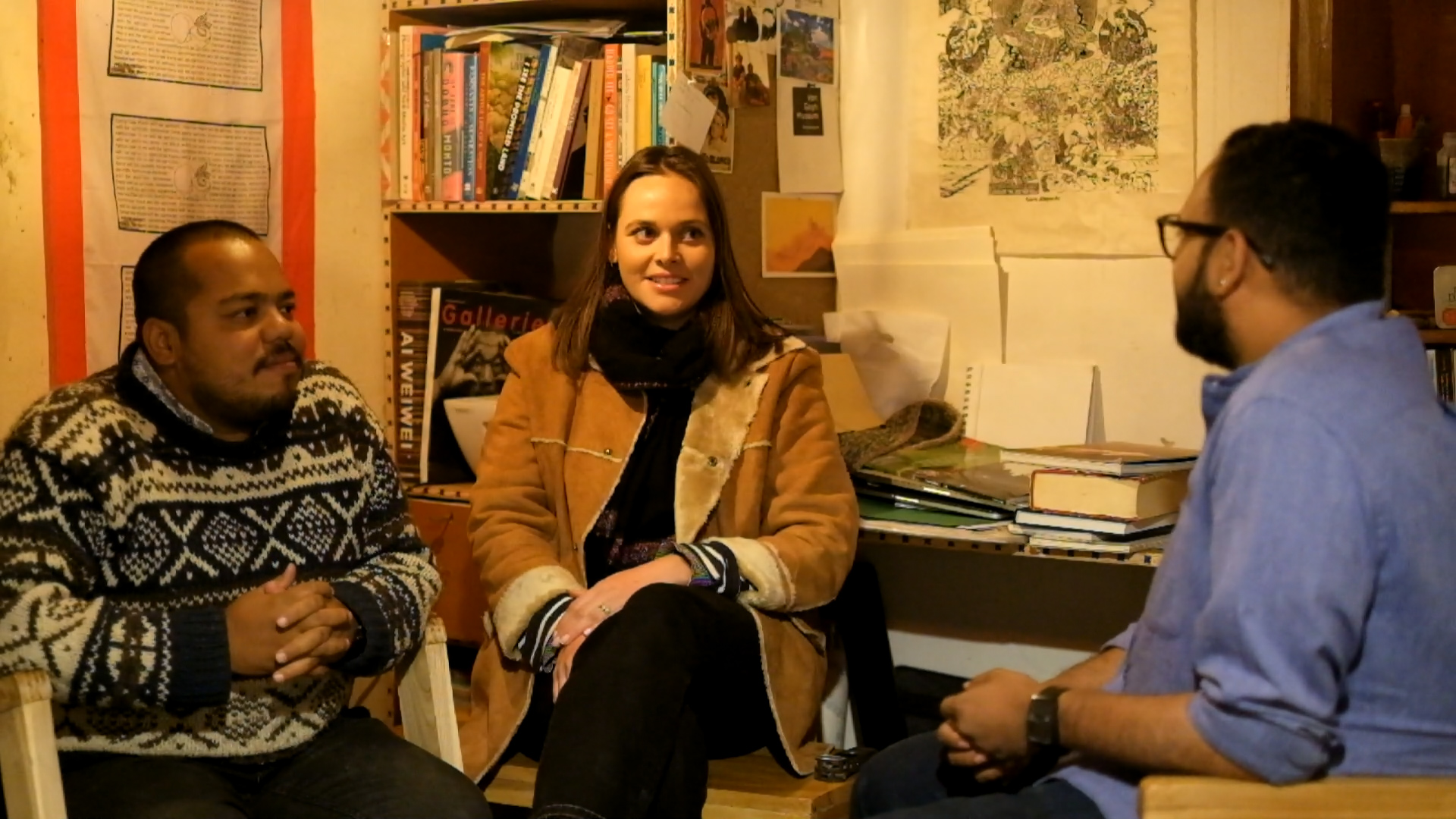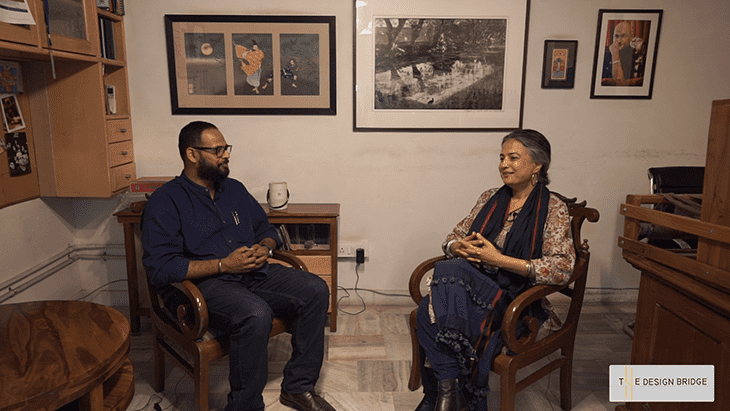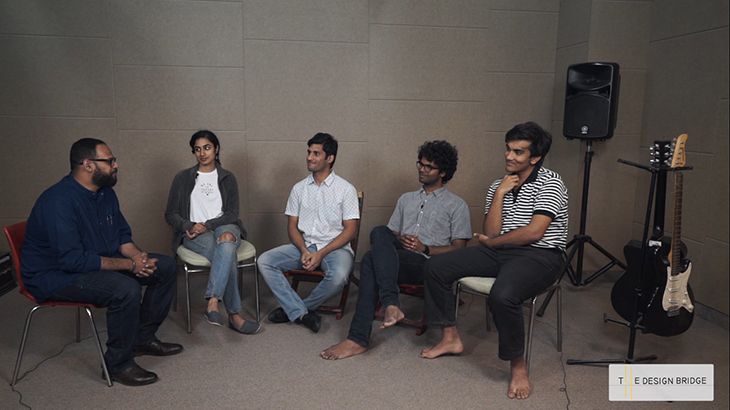ISSUE 1 | STAND POINT

Blue Flames
PROFILE
- He has represented India on various international platforms. He imparted training of blue pottery to the artists in Iceland in 2011. Displayed Blue Pottery articles at International trade fair at Istanbul (Turkey) in 2012. He also trained various student delegation from various other parts of the world including Japan, Germany, Russia, America, etc.
- He had been on the receiving end of various honors and awards. He received the Shilp Guru Award 2016 Ministry of Textiles and National Award 2009 Ministry of Textiles from the Government of India. He had been honored by Mr. Ashok Gehlot too for his excellence in Blue Pottery in 2013.
- He has also been a part of various national workshops. He conducted demonstration of blue pottery at Nehru Center Art Gallery in May 2013. He held a 10 day workshop at Art College of Chandigarh in 2012.
BLUE FLAMES
- TDB : When and how did your journey in the field of blue pottery begin?
- GS : After completing post-graduation in painting I was interested in getting my doctorate. My Ph.d. topic was "The Magnum Opus" of Mr. Kripal Singh Shekhawat. Mr. Kripal Singh Shekhawat was a skilled artisan in the field of blue pottery who was awarded the prestigious Padmashree by the Government of India and was accorded the Epitaph of Shilpguru.
- TDB : How did you get introduced to the craft?
- GS : I was enamored by Mr Kirpal singh’s blue pottery workshop. And after getting to know him and working under him closely for four and a half years I was attracted and eventually got engrossed in the field of blue pottery to the extent that I did not complete my doctorate. My first project was to work on a 16 inch long necked water urn (Surahi). Though Mr. Shekhawat has had a prominent influence on me with regards to this craft and trade, there are always some constraints while working under an established legend as far as individual creative expression is concerned. So we parted ways and I opened my own studio in 1993.
- TDB : Your native and what got you to the city ?
- GS : I was born and brought up in Jaipur. My great-grandfather was a native of Achrol. He was a wood carver who worked in the city palace. I am a post graduate in painting from Rajasthan University. I have been running my studio for 27 years now since 1993.
- TDB : Important event / moment as an artist?
- GS :Mr. Shekhawat was of the opinion that the works produced by regular artisans in this field was somewhat derivative and repetitive; missing original creative impetus and the growth was somewhat stagnant. He fostered the view that this could be vehemently altered if a person with an academic background in this field would start to work at the helm by bringing in his novel ideas in its transformation. His words were always remained etched in my mind and paved the path for me.
- TDB: Do you believe that your craft is dying? If yes why?
- GS: The work of the traditional artisans in this field has been somewhat derivative and repetitive; missing original creative impetus and the growth was somewhat stagnant largely due to the paucity of a disconnect from the demands of the current market.
- TDB: How do you practice your craft? Do you do it the way it has been carried out conventionally or use some modern techniques?
- GS: I believe that the beauty if anything lies in its honesty and the crafts are best practiced in the conventional ways. For our work we attempt to always use authentic ingredients. The unique aspect about Jaipur blue pottery is that it is made from a silica based powder obtained from ‘Chakmak (Flint) Stone’. Its binding capacity is less. To bind katira gum (Tragacanth Gum Herb), glass powder, multani clay (Fuller’s Earth) and Saaji in a specific proportion is added to silica powder. Smaller moulds are constructed to form a larger cast. Metallic oxide based colors are used for overlay painting like oxides of copper (Turquoise Blue), Cobalt (Blue), Chromium (Green), Tin (Yellow). The process of powdering and melting glass has changed over the years- the time taken has increased but so have the safety measures.
- TDB: Have you experimented with the new trends in the crafts ?
- GS: On the outset I started a fusion of blue pottery influenced by the ancient pottery relics of the Indus Valley Civilization and also the medieval folk traditions. This novel experiment of the amalgamation of the old and new became popular and got a lot of traction in the media which in turn made me feel assured and content of the work I was doing.
- Since the blue pottery in Jaipur is made of silica than clay as is done around the world, it is brittle. So lattice work is quite difficult. It took a lot of permutations to ultimately arrive at a sturdy design. I also introduced the architectural elements, the miniature paintings indigenous to Jaipur and even Jain Tantra Shastra in the craft carving trefoil and floral patterns and making miniatures.
- We started getting clients regularly who weren’t just interested in the traditional pottery designs but also started developing a keen eye and inclination towards the modern which helped expand our market via individuals as well as different government organizations, initiatives and art institutions. There was a convivial quid pro quo in the exchange of ideas from my own students with regards to the introduction and advancement of new elements which is going strong to this day. I was conferred with numerous accolades from the national as well as the state government.
- Historically, geometrical, floral and petal designs were being produced. Flower vase, plates of varied diameters were generally made prior. I have experimented with many combinations using different patterns and tools. Nowadays tiles, penholders, bowls or some customized items for niche customers are also produced.
- TDB : You take on the history and changing trends of the craft ?
- GS : Pottery traditions have been there since the dawn of civilization. Blue pottery, specifically has its origin in ancient Persia (where the art was called Sangeene and the artisan- Sangeenesaaj) and was introduced in India during the establishments of different Islamic dynasties. This tradition has been bequeathed upon the local artisans with whom it has evolved to this day. Blue pottery has flourished mainly under the patronage and benevolence of different local kings and chieftains who were ardent benefactors of this art form.
- As is with every art and craft it had started to vanish with the want of support.
- But here in Jaipur, H.H. Sawai Ram Singh (1835-1868) was a great patron of blue pottery. During his reign the craft saw a great surge. Under him many artisans were sent to establish blue pottery workshops from Rajasthan to Delhi.
- In 1962, with the help of Maharani Gayatri Devi and Union Minister Kamala Devi Chattopadhyay, Sawai Ram Singh Shilpshala was established with Mr. Kripal Singh Shekhawat as incharge. The praise and status amassed by the blue pottery tradition has been due to the impassioned efforts of these three people.
 Blue pottery archive
Blue pottery archive
Pic courtesy - Editorial team
- TDB : What is your ‘Stand Point’? Should the crafts be practiced in the traditional ways ? Or do we adopt new trends?
- GS : A craft can only progress when there is a continual assimilation of a plethora of new ideas. I have always held this attitude and have never been reactionary in my approach towards inculcation of novel thoughts and methodologies, be it from the young students or experienced craftsmen. Inculcating these viewpoint and divulging a little from the traditional also caters well to the modern market and provides an impetus to gauge the sensibilities of the younger generations and newer trends.
- TDB : Are there agencies or bodies which help you in sustaining your craft? Who supports you? (Names, agencies and bodies)
- GS : Central govt. runs many programs to promote blue pottery and help the artisans by organizing many workshop, sending the artisans to trade fairs- local, national and international and providing financial help.
- Blue Pottery got Geographical Indication (GI) Tag in 2009.
- We have formed a committee - Jaipur Blue pottery Jankalyan Samiti comprising of 365 people via which we got a patent for Blue Pottery. Though inclusion of people is less but whosoever is getting attached is an enthusiastic participant. We are hopeful of an NGO or some private organisation lending a helping hand and promoting the craft. Many foreign nationals and artisans are in awe of Jaipur Blue Pottery and we have worked and grown in collaboration with both.
- Many art and architecture institutes are also getting associated with student exchange programs so that they can imbibe the tenets and nuances of our art in their craft.
- TDB : What according to you is would be the future of your craft?
- GS : Blue pottery had garnered a lot of traction some years ago. Even though fewer people are getting associated with this craft than before due to rampant mechanization; when this art is arduous and time consuming with the remuneration not being commensurate to the effort, there seems to be a resurgence in aesthetic interior works nowadays which is certainly going to give a boost to blue pottery too.
- TDB : Your word of advice for people wanting to pursue the craft?
- GS : Be welcoming of change, be dedicated and most importantly be patient and produce quality work. It will be the most beneficial if a person has theoretical background in arts and crafts so along with us imparting the practical knowledge during his association with us for say during a course of 5-6 months, will also be able to bring something new to the table.
- TDB : Your advice to the people about crafts like yours? (Advice for the general masses)
- GS: Incorporation and inclusion of the old and the new is the way to go.






